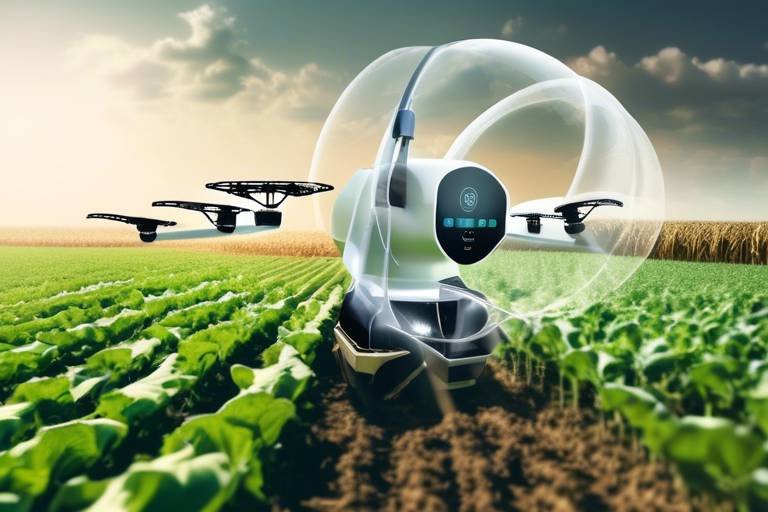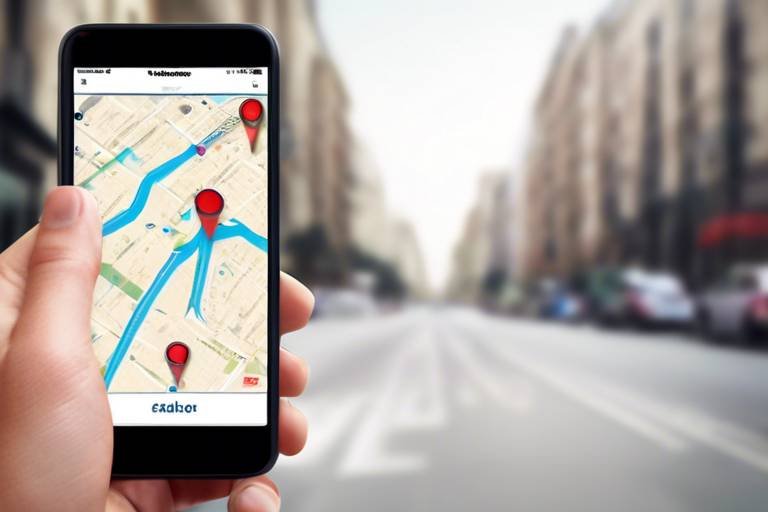The Future of AI in Natural Disaster Response
The world is evolving at an unprecedented pace, and so are the challenges we face, especially when it comes to natural disasters. From hurricanes to earthquakes, the impact of these catastrophic events can be devastating, often leaving communities in disarray. However, the advent of artificial intelligence (AI) is ushering in a new era of hope and innovation in disaster response. Imagine a future where AI not only predicts disasters but also aids in real-time decision-making, ensuring that lives are saved and recovery is swift. This article delves into the transformative role of AI in enhancing our ability to respond to natural disasters, examining innovative applications, the challenges we face, and the promising future that lies ahead.
One of the most significant advancements in disaster response is the use of predictive analytics. By leveraging AI algorithms, we can analyze vast datasets to forecast natural disasters with remarkable accuracy. Think of it as having a crystal ball that can predict not just the occurrence of a disaster, but also its potential impact. This capability allows emergency management teams to implement proactive strategies, ensuring they are prepared long before the storm hits. For instance, AI can analyze historical data, weather patterns, and environmental factors to create data-driven models that inform decision-making. The result? A more resilient society that can withstand the shocks of nature.
In the chaos of a natural disaster, timely information is crucial. AI's ability to process massive amounts of data in real-time is revolutionizing how we respond to emergencies. Picture a scenario where data from various sources—social media, satellite imagery, and IoT devices—are analyzed instantaneously to provide actionable insights. This real-time analysis enables first responders to allocate resources effectively, prioritize rescue operations, and communicate vital information to the public. With AI at the helm, we can ensure that no time is wasted, and every second counts when lives are on the line.
The Internet of Things (IoT) is another game-changer in the realm of disaster management. By connecting various devices, we can gather critical data that enhances AI's capabilities. For example, smart sensors can monitor environmental conditions and detect early signs of a disaster, such as rising water levels or seismic activity. This interconnected network not only aids in real-time monitoring but also facilitates better decision-making during crises. Imagine a scenario where a network of smart devices communicates seamlessly to provide a comprehensive picture of a disaster's impact, enabling authorities to respond promptly and effectively.
Among the most exciting applications of AI in disaster response are smart sensors and drones. These technologies are revolutionizing disaster monitoring and response efforts. Smart sensors can collect data on environmental changes and send alerts to emergency services, while drones can survey affected areas, providing real-time imagery for damage assessment. In search-and-rescue operations, drones equipped with AI can identify survivors in hard-to-reach locations, significantly increasing the chances of successful rescues. This synergy between AI and technology is nothing short of a revolution in how we approach disaster management.
Another fascinating aspect of AI’s role in disaster response is its integration with remote sensing technologies. By analyzing satellite imagery, AI can assess damage and map out recovery efforts after a disaster strikes. This capability is crucial for planning and executing effective recovery strategies. For instance, AI can identify the most affected areas, helping agencies prioritize their response efforts. The ability to visualize disaster impacts from above not only aids in immediate response but also informs long-term recovery planning.
Machine learning algorithms are essential tools in identifying vulnerable areas and populations. By analyzing historical data and current trends, these algorithms enhance risk assessment, allowing for more informed and proactive disaster management strategies. This means that rather than waiting for a disaster to occur, we can anticipate potential risks and take preventive measures. It’s like having a weather radar that doesn’t just tell you when a storm is coming but also helps you prepare your home and community in advance.
Despite its immense potential, implementing AI in disaster response comes with its own set of challenges. Issues such as data privacy, algorithm bias, and the need for robust infrastructure can hinder progress. For instance, while AI can analyze data to make informed decisions, if that data is biased or incomplete, the outcomes can be detrimental. Moreover, the infrastructure required to support these advanced technologies is often lacking in many regions, particularly in developing countries. Addressing these challenges is crucial for harnessing the full potential of AI in disaster response.
As we integrate AI into disaster management, ethical considerations must be at the forefront. The implications of decision-making algorithms can have profound effects on communities, especially in high-stakes situations. Transparency in AI applications is essential to ensure that decisions made during crises are fair and just. We must ask ourselves: how do we ensure that AI serves the best interests of all, especially the most vulnerable populations?
Effective disaster response requires collaboration among various stakeholders, including governments, NGOs, and tech companies. By working together, these entities can enhance AI's impact in crisis situations. Partnerships can lead to shared resources, knowledge, and technology, ultimately improving our collective ability to respond to natural disasters. Imagine a world where everyone—from local communities to international organizations—works hand-in-hand, leveraging AI to save lives and rebuild communities.
The future of AI in disaster management looks incredibly promising. Emerging trends and ongoing research indicate that AI will continue to revolutionize how we respond to natural disasters. With advancements in machine learning, data analytics, and technology integration, we can expect more sophisticated tools that enhance our preparedness and response capabilities. As we move forward, the potential for AI to transform disaster management is not just a possibility; it’s an inevitability that we must embrace.
- How does AI predict natural disasters? AI uses predictive analytics to analyze historical data, weather patterns, and environmental factors to forecast potential disasters.
- What role do drones play in disaster response? Drones equipped with AI can survey affected areas, assess damage, and assist in search-and-rescue operations.
- What are the ethical concerns regarding AI in disaster management? Ethical concerns include data privacy, algorithm bias, and the need for transparency in decision-making processes.
- How can stakeholders collaborate effectively in disaster response? By sharing resources, knowledge, and technology, stakeholders can enhance AI's impact in crisis situations.

AI-Powered Predictive Analytics
Imagine waking up to the sound of a siren blaring, only to realize that a natural disaster is imminent. The panic sets in, but what if we had a way to predict such calamities before they struck? This is where comes into play, revolutionizing how we prepare for and respond to natural disasters. By leveraging vast amounts of data, AI can forecast events like hurricanes, earthquakes, and floods with remarkable accuracy, giving communities a fighting chance to safeguard lives and property.
At its core, predictive analytics utilizes machine learning algorithms to analyze historical data and identify patterns that precede disasters. For instance, by examining weather patterns, geological data, and even social media activity, AI can create models that predict the likelihood of a disaster occurring in a specific area. This data-driven approach enhances preparedness strategies, enabling authorities to allocate resources more effectively and devise evacuation plans that save lives.
One of the most compelling aspects of AI predictive analytics is its ability to provide real-time updates. As new data becomes available, AI models can adjust their predictions accordingly. This adaptability is crucial in a crisis when conditions can change rapidly. For example, during a hurricane, AI systems can analyze satellite imagery and weather reports to refine their forecasts, ensuring that emergency services are always one step ahead.
To illustrate the impact of AI in predictive analytics, consider the following table that outlines various natural disasters and how AI has improved forecasting for each:
| Natural Disaster | AI Application | Impact on Response |
|---|---|---|
| Hurricanes | Predictive modeling of storm paths | Improved evacuation planning |
| Earthquakes | Seismic data analysis | Enhanced building codes and safety measures |
| Floods | Rainfall and river level monitoring | Timely warnings and resource allocation |
The power of AI in predictive analytics doesn't just stop at forecasting. It also plays a vital role in community engagement. By providing accurate predictions and timely information, local governments can keep residents informed and involved in disaster preparedness efforts. This collaboration fosters a culture of resilience, where communities are better equipped to handle emergencies when they arise.
However, it's essential to remember that while AI offers incredible potential, it is not infallible. The accuracy of predictions relies heavily on the quality of data fed into the system. Inaccurate or incomplete data can lead to faulty predictions, which could have dire consequences during a disaster. Therefore, ongoing efforts to improve data collection and analysis are crucial to maximizing the effectiveness of AI in predictive analytics.
In summary, AI-powered predictive analytics is a game-changer in the realm of natural disaster response. By harnessing the power of data, communities can prepare more effectively, respond more swiftly, and ultimately save lives. As technology continues to evolve, the future looks bright for AI's role in enhancing our ability to predict and manage natural disasters.

Real-Time Data Processing
In the chaotic aftermath of a natural disaster, time is of the essence. The quicker we can gather and analyze data, the better equipped we are to save lives and mitigate damage. This is where powered by artificial intelligence (AI) comes into play. Imagine a scenario where emergency responders can access critical information almost instantaneously, allowing them to make informed decisions at a moment's notice. AI can sift through vast amounts of data from various sources, including social media, satellite imagery, and IoT devices, to provide a comprehensive view of the situation on the ground.
One of the most remarkable aspects of AI in disaster response is its ability to analyze data from multiple channels simultaneously. For instance, during a hurricane, AI can monitor weather patterns, track evacuation routes, and assess the impact on infrastructure all at once. This multi-faceted approach enables responders to prioritize their efforts effectively. Instead of reacting to events as they unfold, they can anticipate needs and deploy resources where they are most needed, transforming chaos into order.
Let's break down how this works in practice. AI algorithms can process data from:
- Social Media: Posts and updates from individuals in affected areas can provide real-time insights into conditions on the ground.
- Weather Stations: Continuous updates on weather patterns help in predicting the trajectory of storms or floods.
- IoT Sensors: Smart devices can relay information about structural integrity, water levels, and air quality.
- Satellite Imagery: High-resolution images can reveal the extent of damage and help in planning recovery efforts.
Moreover, AI can enhance communication between various agencies involved in disaster response. By creating a centralized platform where data is shared and analyzed, different organizations can work together more effectively. This kind of collaboration is crucial, as it allows for a more coordinated response, minimizing the risk of duplicated efforts and ensuring that resources are allocated efficiently.
However, while the benefits of real-time data processing are clear, it does come with challenges. The sheer volume of data can be overwhelming, and not all data is equally reliable. AI systems must be trained to distinguish between credible information and noise. Additionally, there are concerns regarding data privacy and the ethical implications of using personal information during emergencies. As we move forward, addressing these challenges will be essential to harnessing the full potential of AI in disaster response.
In summary, real-time data processing through AI is revolutionizing how we respond to natural disasters. By providing timely and accurate information, AI empowers decision-makers to act swiftly and effectively, ultimately leading to better outcomes for those affected. As technology continues to advance, we can expect even more innovative solutions that will enhance our ability to predict, prepare for, and respond to natural disasters.
- How does AI improve disaster response?
AI enhances disaster response by providing real-time data analysis, allowing for quicker decision-making and more effective resource allocation. - What types of data does AI analyze during disasters?
AI analyzes data from social media, weather stations, IoT sensors, and satellite imagery to create a comprehensive understanding of the situation. - What are the challenges of using AI in disaster management?
Challenges include data privacy concerns, the need for reliable data sources, and the ethical implications of AI decision-making. - Can AI help in predicting natural disasters?
Yes, AI-powered predictive analytics can forecast natural disasters with greater accuracy, enhancing preparedness and response strategies.

Integration with IoT Devices
The integration of Internet of Things (IoT) devices with artificial intelligence (AI) is a game-changer in the realm of disaster management. Imagine a network of smart devices, each equipped with sensors, communicating with one another to gather and analyze data in real-time. This synergy allows for a more comprehensive understanding of the evolving situation during a natural disaster. For instance, when a hurricane is approaching, IoT devices can monitor wind speeds, rainfall, and even the structural integrity of buildings, sending this crucial information directly to AI systems that can process it almost instantaneously.
One of the most remarkable aspects of IoT integration is the ability to collect data from various sources, including weather stations, emergency response teams, and even social media feeds. This multifaceted approach ensures that decision-makers have access to the most accurate and up-to-date information. For example, during a flood, IoT-enabled sensors can detect rising water levels in real-time, prompting AI algorithms to analyze patterns and predict which areas are at the highest risk of inundation. This proactive approach not only saves lives but also facilitates timely evacuations and resource allocation.
Moreover, the use of IoT devices enhances the overall efficiency of emergency response. When a disaster strikes, responders can rely on a network of interconnected devices that provide vital information about the situation on the ground. For instance, drones equipped with cameras and sensors can survey affected areas, capturing images and data that AI can analyze to assess damage and prioritize rescue operations. This is akin to having a bird's-eye view of the disaster zone, allowing responders to make informed decisions based on real-time insights.
However, the integration of IoT devices with AI also brings challenges. Issues such as data privacy and security must be addressed to ensure that the information collected is used responsibly. Furthermore, the reliability of IoT devices in extreme conditions can be a concern. To mitigate these risks, it is essential to establish robust protocols and standards for data collection and transmission.
In summary, the integration of AI with IoT devices is revolutionizing disaster response by providing real-time data, enhancing situational awareness, and improving decision-making processes. As technology continues to evolve, we can expect even more innovative applications that will help us better prepare for and respond to natural disasters.
- What are IoT devices?
IoT devices are interconnected devices equipped with sensors and software that enable them to collect and exchange data over the internet. - How does AI improve disaster response?
AI enhances disaster response by analyzing vast amounts of data quickly, predicting potential risks, and providing actionable insights to responders. - What challenges exist with AI and IoT integration?
Challenges include data privacy concerns, security risks, and the reliability of devices in extreme conditions. - Can AI predict natural disasters?
While AI cannot predict disasters with 100% accuracy, it can analyze data trends to provide forecasts that improve preparedness.

Smart Sensors and Drones
In the realm of disaster response, smart sensors and drones are emerging as game changers, revolutionizing how we monitor and assess natural disasters. Imagine a world where technology not only alerts us to impending disasters but also actively participates in the rescue and recovery processes. Smart sensors, equipped with advanced capabilities, can detect environmental changes—like sudden shifts in temperature, humidity, or seismic activity—that might indicate an impending disaster. These sensors collect real-time data, which is then analyzed using artificial intelligence to predict potential risks and enhance emergency preparedness.
Drones, on the other hand, offer a bird's-eye view of disaster-stricken areas, providing critical information that can be challenging to obtain from the ground. Equipped with high-resolution cameras and sensors, drones can quickly survey vast areas, allowing emergency responders to assess damage, locate survivors, and deliver supplies. For instance, during a flood, drones can map out affected regions, identify safe routes for evacuation, and even assist in search-and-rescue operations by pinpointing the locations of stranded individuals.
One of the most significant advantages of using drones in disaster response is their ability to operate in hazardous environments where human access might be limited or dangerous. They can navigate through debris, smoke, or unstable structures, providing essential information without putting lives at risk. Moreover, when paired with smart sensors, drones can autonomously collect and transmit data, creating a comprehensive picture of the disaster's impact in real-time.
To illustrate the effectiveness of smart sensors and drones in disaster management, consider the following table that summarizes their key roles:
| Technology | Key Functions | Benefits |
|---|---|---|
| Smart Sensors |
|
|
| Drones |
|
|
As we look to the future, the integration of smart sensors and drones into emergency management strategies holds immense potential. By harnessing the power of these technologies, we can not only improve our response times but also save lives and reduce the overall impact of natural disasters. The collaboration between AI, smart sensors, and drones is paving the way for a more resilient and prepared society, ready to face the challenges posed by natural disasters.
Q1: How do smart sensors work in disaster response?
Smart sensors continuously monitor environmental conditions and can detect changes that may indicate a disaster. They collect data which is analyzed to provide early warnings and improve preparedness.
Q2: What types of drones are used in disaster management?
Various drones are used, including fixed-wing drones for long-range surveys and quadcopters for detailed close-up assessments. Both can be equipped with cameras and sensors for real-time data collection.
Q3: Can drones operate in adverse weather conditions?
While many drones are designed to withstand some adverse weather, their operational capabilities can be limited in extreme conditions like heavy rain or strong winds. However, advancements in drone technology are continually improving their resilience.
Q4: How do AI and drones work together?
AI processes the data collected by drones to provide actionable insights, such as identifying areas of high damage or locating survivors, enhancing overall disaster response efforts.

Remote Sensing Technologies
Remote sensing technologies are revolutionizing the way we approach disaster response by providing critical data that can be analyzed for effective decision-making. These technologies utilize satellites and aerial imagery to monitor environmental changes and assess damage after a disaster strikes. Imagine a bird's-eye view of a disaster area, capturing every detail from above, allowing emergency responders to strategize their efforts effectively. This capability is not just a luxury; it is a necessity in today's fast-paced world where time is of the essence.
By employing advanced algorithms, remote sensing technologies can process vast amounts of data quickly, enabling responders to visualize the extent of damage in real-time. For instance, after a hurricane, satellite images can reveal flooded areas, damaged buildings, and even the movement of debris. This information is invaluable as it helps agencies prioritize their response efforts and allocate resources where they are needed most. The integration of AI in analyzing these images further enhances the accuracy and speed of assessments, making it easier to identify areas that require immediate attention.
Additionally, remote sensing technologies can be incredibly beneficial in the recovery phase of disaster management. They can track changes in land use and infrastructure over time, providing insights into how communities can rebuild more resiliently. By analyzing pre- and post-disaster imagery, planners can identify vulnerabilities and design strategies that mitigate future risks. This proactive approach not only aids in recovery but also fosters a culture of preparedness among communities, ensuring they are better equipped for the next disaster.
The data derived from remote sensing is often displayed in various formats, such as heat maps and 3D models, making it easier for decision-makers to comprehend complex information quickly. These visual aids are crucial for communicating with stakeholders, including government agencies, NGOs, and the general public. When everyone has access to clear and concise information, the collaborative response to disasters becomes more effective.
In summary, remote sensing technologies are a game-changer in disaster response and recovery. They provide timely, accurate, and actionable data that enhances situational awareness and informs strategic decision-making. As these technologies continue to evolve, their integration with AI will only become more sophisticated, paving the way for a more resilient future in emergency management.
- What are remote sensing technologies?
Remote sensing technologies involve the use of satellites and aerial imagery to monitor and analyze environmental changes, particularly during and after natural disasters. - How do remote sensing technologies aid in disaster response?
They provide real-time data on damage assessment, enabling responders to prioritize their efforts and allocate resources effectively. - Can remote sensing technologies help in recovery efforts?
Yes, they can track changes over time, allowing planners to identify vulnerabilities and develop strategies for rebuilding more resilient communities. - What role does AI play in remote sensing?
AI enhances the analysis of remote sensing data, improving the accuracy and speed of assessments, which is crucial during emergencies.

Machine Learning in Risk Assessment
When it comes to disaster management, understanding risk is paramount. This is where machine learning steps in as a game-changer. By harnessing vast amounts of data, machine learning algorithms can identify patterns and predict which areas are most vulnerable to natural disasters. Imagine having a crystal ball that not only forecasts the weather but also pinpoints communities at risk of flooding, earthquakes, or wildfires. That’s the power of AI in risk assessment!
To illustrate this, consider how these algorithms process historical data on past disasters. They analyze factors such as geographical location, population density, infrastructure resilience, and even social media activity to assess risk levels. For instance, a machine learning model might analyze thousands of tweets during a storm to gauge public sentiment and identify areas where people are feeling the most anxious or threatened. This real-time data can be invaluable for emergency responders looking to allocate resources effectively.
Furthermore, machine learning can significantly enhance the accuracy of risk assessments by continuously learning from new data. As more information becomes available, these algorithms refine their predictions, leading to better preparedness strategies. For example, if a particular area has experienced a series of floods over the past few years, the model can adjust its risk profile to reflect this trend, prompting local authorities to take preemptive measures.
However, it's essential to note that while machine learning offers immense potential, it is not without challenges. Issues such as data quality, availability, and algorithm bias can impact the effectiveness of risk assessments. For instance, if the data used to train a model is incomplete or skewed, the predictions may lead to misallocation of resources. Therefore, ensuring high-quality data and transparency in how algorithms are developed is critical for the success of machine learning in disaster risk assessment.
In summary, machine learning is revolutionizing how we assess risk in the context of natural disasters. By leveraging data-driven insights, we can enhance our preparedness and response strategies, ultimately saving lives and reducing the impact of disasters on communities. As technology continues to evolve, the integration of machine learning into risk assessment will likely become even more sophisticated, paving the way for a safer future.
- What is machine learning? Machine learning is a subset of artificial intelligence that enables systems to learn from data and improve their performance over time without being explicitly programmed.
- How does machine learning help in disaster risk assessment? Machine learning analyzes vast data sets to identify patterns and predict vulnerable areas, improving preparedness and response strategies.
- What are the challenges of using machine learning in disaster management? Challenges include data quality, algorithm bias, and the need for transparency in how algorithms are developed and used.
- Can machine learning predict all types of natural disasters? While machine learning can significantly enhance predictions, it may not be able to predict every disaster with complete accuracy due to the complexity of natural phenomena.

Challenges in AI Implementation
While the potential of artificial intelligence in natural disaster response is immense, there are several significant challenges that must be addressed to fully harness its capabilities. One of the primary concerns is data privacy. In many cases, the data collected for AI algorithms includes sensitive information about individuals and communities. Striking a balance between leveraging data for effective disaster response and protecting personal privacy is crucial. For instance, how can we ensure that the data used to predict disasters does not infringe on the rights of individuals? This question remains a key consideration for policymakers and technologists alike.
Another major hurdle is algorithm bias. AI systems learn from historical data, and if that data contains biases, the algorithms may perpetuate or even exacerbate existing inequalities. For example, if an AI model is trained predominantly on data from urban areas, it may not accurately predict disasters in rural or marginalized communities. This could lead to inadequate responses and further risks for those already vulnerable. Thus, ensuring that the data sets used for training AI are diverse and representative is essential for fair outcomes.
Moreover, the implementation of AI technologies in disaster response often requires a robust infrastructure. Many regions, particularly those prone to natural disasters, may lack the necessary technological foundation to support sophisticated AI systems. For instance, areas affected by frequent hurricanes or earthquakes may struggle with outdated communication networks, making it difficult to deploy AI tools effectively. This technological gap can hinder timely responses and diminish the overall effectiveness of AI applications in crisis situations.
In addition to these technical challenges, there’s also the issue of stakeholder collaboration. Effective disaster response necessitates cooperation among various entities, including government agencies, non-governmental organizations (NGOs), and technology companies. Each stakeholder may have different priorities and approaches, which can complicate the integration of AI into existing disaster management frameworks. Therefore, establishing clear communication channels and shared goals is vital to ensure that AI technologies are utilized effectively and efficiently.
Lastly, we must consider the ethical implications of using AI in disaster scenarios. As AI systems increasingly take on decision-making roles, questions about accountability arise. Who is responsible when an AI-driven decision leads to negative outcomes? Addressing these ethical concerns is paramount to fostering public trust in AI technologies and ensuring that they are deployed responsibly.
- What are the main challenges in implementing AI for disaster response?
Some of the key challenges include data privacy, algorithm bias, infrastructure limitations, stakeholder collaboration, and ethical considerations. - How can we ensure data privacy while using AI?
Implementing strict data governance policies and utilizing anonymization techniques can help protect individual privacy while still leveraging data for AI. - Why is algorithm bias a concern in disaster response?
Algorithm bias can lead to inequitable disaster responses, particularly for marginalized communities, if the AI models are not trained on diverse and representative data. - What role do stakeholders play in AI implementation?
Collaboration among stakeholders—governments, NGOs, and tech companies—is essential for effective integration and utilization of AI technologies in disaster management. - What ethical considerations should be taken into account?
Ethical considerations include accountability for AI-driven decisions, transparency in algorithms, and ensuring that AI is used to benefit all communities fairly.

Ethical Considerations
The integration of artificial intelligence (AI) in disaster response is a double-edged sword, bringing both remarkable benefits and significant ethical dilemmas. As we embrace the advancements that AI offers, it is crucial to navigate the murky waters of ethics, particularly in high-stakes scenarios such as natural disasters. One major concern is the decision-making algorithms that AI systems employ. These algorithms can significantly influence the outcomes of disaster response efforts, but they often operate as a "black box," making it difficult to understand how decisions are made. This lack of transparency can lead to distrust among affected communities and stakeholders.
Moreover, there is the risk of algorithmic bias. If the data used to train these AI systems is skewed or unrepresentative, the outcomes can disproportionately affect marginalized populations. For example, if an AI model is primarily trained on data from urban areas, it may fail to accurately predict or respond to disasters in rural communities. This raises questions about equity and fairness in disaster management, as vulnerable populations could be left behind in the wake of a disaster.
Additionally, the ethical implications of data privacy cannot be overlooked. During emergencies, vast amounts of personal data may be collected to enhance AI's functionality. However, the collection and usage of this data must be handled with utmost care to protect individuals' privacy rights. There is a fine line between utilizing data for the greater good and infringing upon personal freedoms. Thus, clear guidelines and regulations are essential to ensure that data collection practices are ethical and transparent.
In light of these considerations, it is essential to foster an environment of collaboration and dialogue among stakeholders. This includes governments, NGOs, tech companies, and the communities they serve. By establishing partnerships and engaging in open discussions, stakeholders can work together to address ethical concerns and develop AI systems that prioritize fairness, transparency, and accountability. Engaging communities in the development process can also help ensure that the AI tools created are sensitive to the needs of those they are designed to assist.
Ultimately, the ethical considerations surrounding AI in disaster response are complex and multifaceted. As we look to the future, it is imperative to approach these challenges with a proactive mindset, ensuring that the deployment of AI technologies enhances, rather than undermines, the integrity of disaster response efforts.
- What are the main ethical concerns regarding AI in disaster response?
Key concerns include algorithmic bias, data privacy, and transparency in decision-making processes.
- How can we ensure fairness in AI algorithms used for disaster management?
By using diverse and representative data sets, and involving community stakeholders in the development process.
- What role do stakeholders play in addressing ethical issues in AI?
Collaboration among governments, NGOs, tech companies, and communities is essential to ensure ethical considerations are prioritized.
- Why is transparency important in AI decision-making?
Transparency builds trust among affected communities and helps ensure that AI systems are accountable for their decisions.

Collaboration Among Stakeholders
The role of in disaster response cannot be overstated. When natural disasters strike, the complexity of the situation often requires a multi-faceted approach, bringing together various parties to ensure an efficient and effective response. Think of it as a well-orchestrated symphony, where each musician plays their part to create a harmonious outcome. In this context, the musicians are governments, non-governmental organizations (NGOs), tech companies, and local communities, each contributing unique resources and expertise to the disaster management process.
One of the key benefits of collaboration is the pooling of resources. For instance, governments can provide funding and infrastructure, while NGOs can offer on-ground support and local knowledge. Tech companies, with their cutting-edge innovations, can supply the necessary tools and technology to enhance communication and data analysis. By working together, these stakeholders can create a robust framework that not only addresses immediate needs but also lays the groundwork for long-term recovery and resilience.
Moreover, effective communication is essential in disaster scenarios. Stakeholders must establish clear channels for information sharing. This is where technology plays a crucial role. For example, AI-driven platforms can facilitate real-time data exchange, ensuring that all parties are on the same page. Imagine a scenario where a natural disaster occurs, and within minutes, all stakeholders receive accurate updates about the situation, enabling them to respond swiftly and efficiently. This level of coordination can significantly reduce the impact of disasters on affected populations.
However, collaboration is not without its challenges. Different stakeholders may have varying priorities and approaches to disaster management. For instance, while a government might focus on large-scale logistics, an NGO may prioritize direct community engagement. To overcome these hurdles, it is vital to foster a culture of trust and understanding among all parties involved. Regular meetings, joint training exercises, and shared goals can help bridge the gap between different stakeholders, creating a unified front in the face of adversity.
Additionally, it is essential to involve local communities in the planning and execution of disaster response strategies. These individuals often have invaluable insights into their environments and can provide critical information that outside organizations might overlook. By empowering local voices, stakeholders can develop more effective and culturally sensitive disaster response plans. This collaborative approach not only enhances the overall response but also builds community resilience, enabling them to recover more quickly from future disasters.
In summary, the success of disaster response hinges on the collaboration among various stakeholders. By leveraging each other's strengths, sharing resources, and fostering open communication, we can create a more effective and comprehensive disaster management strategy. As we look towards the future, embracing this collaborative spirit will be essential to navigating the increasingly complex landscape of natural disasters.
- Why is collaboration among stakeholders important in disaster response?
Collaboration ensures that resources, expertise, and information are shared effectively, leading to a more coordinated and efficient response to disasters. - What are some challenges faced in stakeholder collaboration?
Challenges include differing priorities, communication barriers, and the need for trust and understanding among diverse groups. - How can technology enhance collaboration?
Technology facilitates real-time data sharing and communication, allowing stakeholders to stay informed and respond quickly during emergencies. - Why should local communities be involved in disaster management?
Local communities possess critical knowledge about their surroundings and can provide insights that improve the effectiveness of disaster response plans.

Future Prospects of AI in Disaster Management
The future of artificial intelligence (AI) in disaster management is not just bright; it’s glowing with potential! As we look ahead, we can see that AI is set to redefine how we prepare for, respond to, and recover from natural disasters. Imagine a world where predictive models not only forecast disasters but also provide tailored responses that save lives and resources. This is not science fiction; this is the emerging reality of AI in disaster management.
One of the most exciting prospects is the integration of AI with big data. With the exponential growth of data generated from various sources—social media, weather patterns, and satellite imagery—AI can analyze this information in real-time to provide actionable insights. This means that emergency responders can receive alerts about impending disasters before they occur, allowing for timely evacuations and resource allocation. Think of it as having a supercharged crystal ball that helps communities prepare for the worst.
Moreover, the ongoing advancements in machine learning algorithms are enhancing our ability to identify at-risk populations and areas. By analyzing historical data and current trends, AI can pinpoint regions that are most vulnerable to disasters, enabling governments and organizations to implement proactive measures. This predictive capability is akin to having a weather radar that not only tells you when a storm is coming but also suggests the best course of action to mitigate its impact.
As we move forward, we can also expect to see a greater emphasis on collaboration between AI technologies and human expertise. While AI can process data at lightning speed, the human touch is irreplaceable in understanding local contexts and making nuanced decisions. The synergy between AI and human responders will create a more effective disaster management framework, where technology assists but does not overshadow the critical role of human judgment.
Furthermore, the development of autonomous technologies, such as drones and robots, will revolutionize search-and-rescue operations. These machines can navigate hazardous environments, collect data, and perform tasks that are too dangerous for human responders. Imagine a drone flying into a disaster zone, equipped with AI capabilities, to assess damage and locate survivors—all while keeping human responders safe. This is the future that is already on the horizon.
However, as we embrace these advancements, it’s crucial to remain aware of the challenges that lie ahead. Issues such as data privacy, algorithm bias, and the need for robust infrastructure must be addressed to ensure that AI technologies are implemented ethically and effectively. The conversation around these challenges is vital, as it will shape the policies and frameworks that govern the use of AI in disaster management.
In conclusion, the future prospects of AI in disaster management are not just promising; they are transformative. With ongoing research and innovation, AI has the potential to revolutionize our approach to natural disasters, making us better prepared, more responsive, and ultimately more resilient. As we harness the power of AI, we must also commit to doing so responsibly, ensuring that technology serves humanity in its most critical moments.
- How does AI improve disaster response?
AI enhances disaster response by providing predictive analytics, real-time data processing, and risk assessment, allowing for better preparedness and quicker reactions during emergencies.
- What role do drones play in disaster management?
Drones equipped with AI can assess damage, locate survivors, and gather data in hazardous environments, significantly improving search-and-rescue operations.
- What are the ethical considerations of using AI in disaster response?
Ethical considerations include data privacy, algorithm bias, and the need for transparency in decision-making processes to ensure fair and effective outcomes.
- How can collaboration enhance AI's impact in disaster management?
Collaboration among governments, NGOs, and tech companies can lead to shared resources, knowledge, and technology, improving overall disaster response efforts.
Frequently Asked Questions
- What is the role of AI in predicting natural disasters?
AI plays a crucial role in predicting natural disasters by utilizing predictive analytics. These advanced models analyze historical data and current environmental conditions to forecast events like hurricanes, earthquakes, and floods with greater accuracy. This helps communities prepare and respond effectively, potentially saving lives and reducing damage.
- How does AI process real-time data during emergencies?
AI systems can process vast amounts of data from various sources in real-time, such as social media feeds, weather sensors, and satellite imagery. By analyzing this data quickly, AI provides timely information that aids emergency responders in making informed decisions during crises, ensuring resources are allocated efficiently when every second counts.
- What are smart sensors and how do they assist in disaster response?
Smart sensors are interconnected devices that gather critical data during disasters. They monitor environmental conditions, detect hazards, and provide real-time feedback to response teams. When combined with AI, these sensors enhance situational awareness, enabling quicker assessments of damage and more effective search-and-rescue operations.
- What challenges does AI face in disaster management?
Implementing AI in disaster management comes with challenges such as data privacy concerns, potential algorithm bias, and the need for a robust technological infrastructure. Additionally, ensuring that AI systems are transparent and accountable is essential to maintain public trust and effectiveness in crisis situations.
- How can stakeholders collaborate to improve AI's impact in disaster response?
Collaboration among stakeholders—governments, NGOs, and tech companies—is vital for maximizing AI's potential in disaster response. By sharing resources, data, and expertise, these groups can develop more effective AI solutions that enhance preparedness and response strategies, ultimately leading to better outcomes during emergencies.
- What does the future hold for AI in disaster management?
The future of AI in disaster management is bright, with ongoing research and emerging trends promising to revolutionize how we respond to natural disasters. Innovations in machine learning, data integration, and remote sensing technologies are set to enhance our ability to predict, assess, and manage crises, making communities safer and more resilient.



















